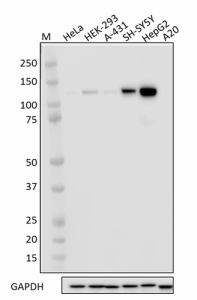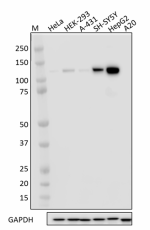- Clone
- W18139A (See other available formats)
- Regulatory Status
- RUO
- Other Names
- EML4, Echinoderm microtubule-associated protein-like 4
- Isotype
- Rat IgG2b, κ
- Ave. Rating
- Submit a Review
- Product Citations
- publications

-

Whole cell extracts (15 µg protein) from the indicated cell lines were resolved by 4-12% Bis-Tris gel electrophoresis, transferred to a PVDF membrane, and probed with 1.0 µg/mL (1:500 dilution) of Purified anti-EML4 Antibody, clone W18139A, overnight at 4°C. Proteins were visualized by chemiluminescence detection using HRP Goat anti-rat IgG Antibody (Cat. No. 405405) at a 1:3000 dilution. Direct-Blot™ HRP anti-GAPDH Antibody (Cat. No. 607904) was used as a loading control at a 1:50,000 dilution (lower). Lane M: Molecular Weight marker. Cell lines were loaded in order of increasing predicted EML4 expression (source: Human Protein Atlas). -

HepG2 cells were fixed with 4% paraformaldehyde for 10 minutes, permeabilized with ice-cold Methanol for 10 minutes, and blocked with 5% FBS for 60 minutes. Cells were then intracellularly stained with a 1:100 dilution (5.0 µg/mL) of either Purified Rat IgG2b, κ Isotype Control Antibody (Cat. No. 400602, panel A) or Purified anti-EML4 Antibody, clone W18139A (panel B) overnight at 4°C, followed by incubation with Alexa Fluor® 594 goat anti-rat IgG (Cat. No. 405422) at 2.0 µg/mL. Nuclei were counterstained with DAPI, and the image was captured with a 60X objective.
| Cat # | Size | Price | Quantity Check Availability | Save | ||
|---|---|---|---|---|---|---|
| 670801 | 25 µg | 81€ | ||||
| 670802 | 100 µg | 203€ | ||||
Echinoderm microtubule-associated protein-like 4 or EML4 plays a central role in the modification of microtubule structural dynamics and morphology. During mitosis, EML4 expression is upregulated and is associated with spindle formation. In lung cancer cells, a translocation mutation is associated with the EML4 gene, where parts of the gene fuses with the anaplastic lymphoma receptor tyrosine kinase (ALK) gene and generates an EML4-ALK fusion protein.
Product DetailsProduct Details
- Verified Reactivity
- Human
- Antibody Type
- Monoclonal
- Host Species
- Rat
- Immunogen
- Partial recombinant human EML4 protein.
- Formulation
- Phosphate-buffered solution, pH 7.2, containing 0.09% sodium azide
- Preparation
- The antibody was purified by affinity chromatography.
- Concentration
- 0.5 mg/ml
- Storage & Handling
- The antibody solution should be stored undiluted between 2°C and 8°C.
- Application
-
WB - Quality tested
ICC - Verified - Recommended Usage
-
Each lot of this antibody is quality control tested by Western blotting. For Western blotting, the suggested use of this reagent is 0.05 - 1.0 µg/mL. For immunocytochemistry, a concentration of 1.0 μg/mL is recommended. It is recommended that the reagent be titrated for optimal performance for each application.
- Application Notes
-
This clone has not been tested for IP.
- RRID
-
AB_2814524 (BioLegend Cat. No. 670801)
AB_2814524 (BioLegend Cat. No. 670802)
Antigen Details
- Structure
- EML4 is a 981 amino acid protein with a predicted molecular weight of 109 kD
- Distribution
-
Cytoskeleton/Ubiquitously expressed
- Function
- Microtubule formation
- Antigen References
-
- Yoshida A, et al. 2011. J Thorac Oncol. 10:1677-86.
- Soda M, et al. 2007. Nature. 448:561.
- Pollmann M, et al. 2006. Exp Cell Res. (17):3241-51.
- Gene ID
- 27436 View all products for this Gene ID
- UniProt
- View information about EML4 on UniProt.org
Related Pages & Pathways
Pages
Related FAQs
Other Formats
View All EML4 Reagents Request Custom Conjugation| Description | Clone | Applications |
|---|---|---|
| Purified anti-EML4 | W18139A | WB,ICC |
Compare Data Across All Formats
This data display is provided for general comparisons between formats.
Your actual data may vary due to variations in samples, target cells, instruments and their settings, staining conditions, and other factors.
If you need assistance with selecting the best format contact our expert technical support team.

 Login / Register
Login / Register 









Follow Us